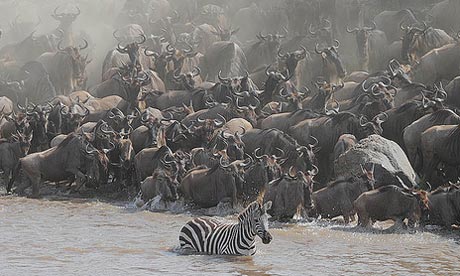
The Great Migration is a must for any wannabe wildlife photographer, follow these golden rules for snapping the Serengeti’s superstars
A veteran of over 1,000 game drives, Wanderlust’s Contributing Editor Paul Goldstein has spent over a year of his life following the Migration. Here are Paul’s 15 top tips for making your Great Migration images memorable.
The most valuable commodity is time, so make sure you have plenty and that it’s maximised.
Don’t come out thinking ‘I want to take a picture of a leopard up a tree,’ because you’ve seen it before: put your own stamp on your images – make them yours.
Just pointing the camera and making the image sharp is not enough. Try lowering the shutter speed or a more unconventional composition sometimes. The bolder you are, the more you will fail – but when you succeed…
80% of a portrait is governed by its background. The subject is stationary, it should be sharp but if what’s behind it is messy it will distract the viewer.
Early or late is the general rule. One leopard or lion at seven in the morning is worth a hundred at nine… and one beautifully back-lit is generally worth two front-lit.
These are the moments that photographers cherish. Even one well-lit cheetah is relegated to also-ran next to a sharp cheetah-chase image.
Make sure your vehicle has big beanbags to rest your lens on. Just because your lens is stabilised does not mean every shot will be sharp.
These days, cameras permit incredibly high ISO’s (sensitivity to light) meaning that bad light isn’t an obstacle. However, unless the subject or action is very rare should you really be photographing it?
A knowledgeable and sensitive approach will always generate better pictures. The very best wildlife images are often the result of immense patience but also a spiritual understanding of the subject. Being able to anticipate an animal’s movements is a huge advantage.
Just blazing away is never a reward guarantee. Be selective. Just because a camera does ten frames-a-second does not mean the shutter has to be leant on all day.
If you have a better one, delete all the others. They will just clutter up your hard drive.
Don’t chase the prize. You will just harass them and get endless ‘arse’ shots. Better to gamble with your position, it may not worth first time but when it does it can be ‘grail’ time.
‘If you don’t look you can’t see’ is a fantastic adage that’s very pertinent to the Great Migration. Spend time just enjoying this extraordinary phenomenon and thinking about your photography – you’ll take better photographs for it (and better company too).
Endless shots of dark unending lines of ruminants get dull after a while. A shot of a huge herd with an appropriately placed vehicle in it will sell the story much more to your friends – and publications!
The wildlife photographer’s trinity of patience, sensitivity and sweat add up to graft - if you are not prepared to put the work in, don’t expect anything special from your camera or your safari.
More top tips for photographing wildlife from Steve Davey | Advice... More
Check out our wildlife and safaris travel guide | Plan a trip... More
'The ultimate African safari' | Destinations... More
'Climbing Kilimanjaro' | Destinations... More
'Get shot of cliches: photographing travel icons' | Advice... More